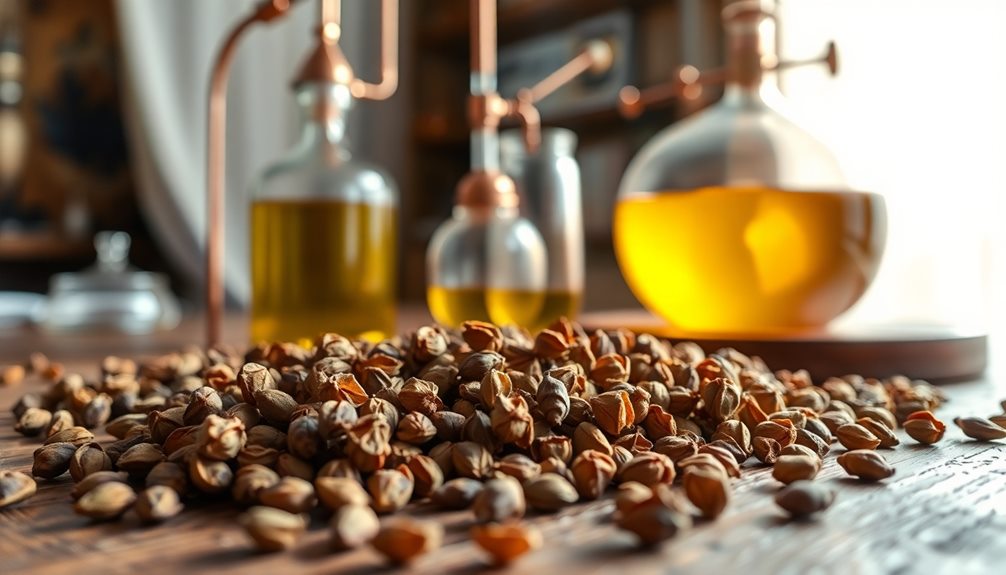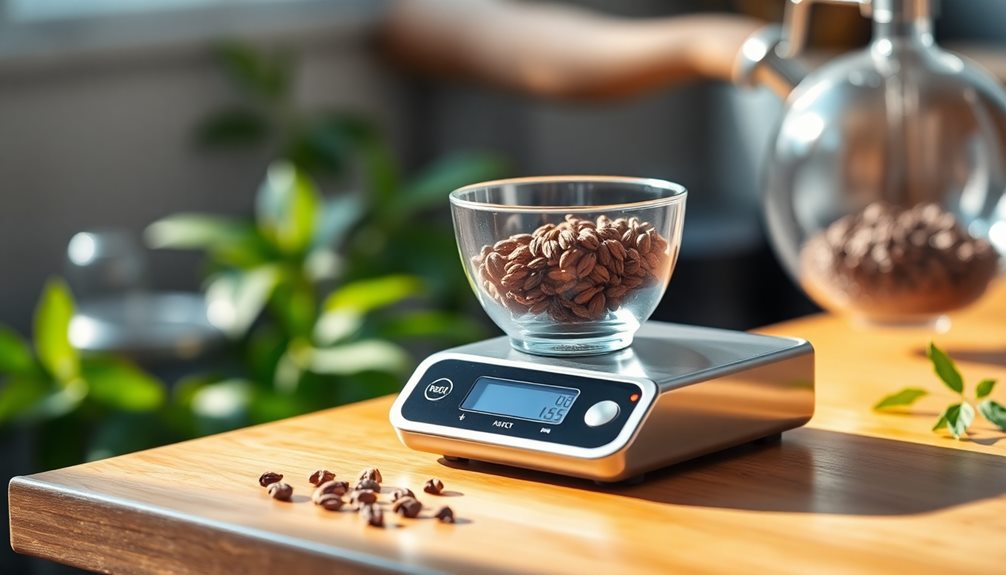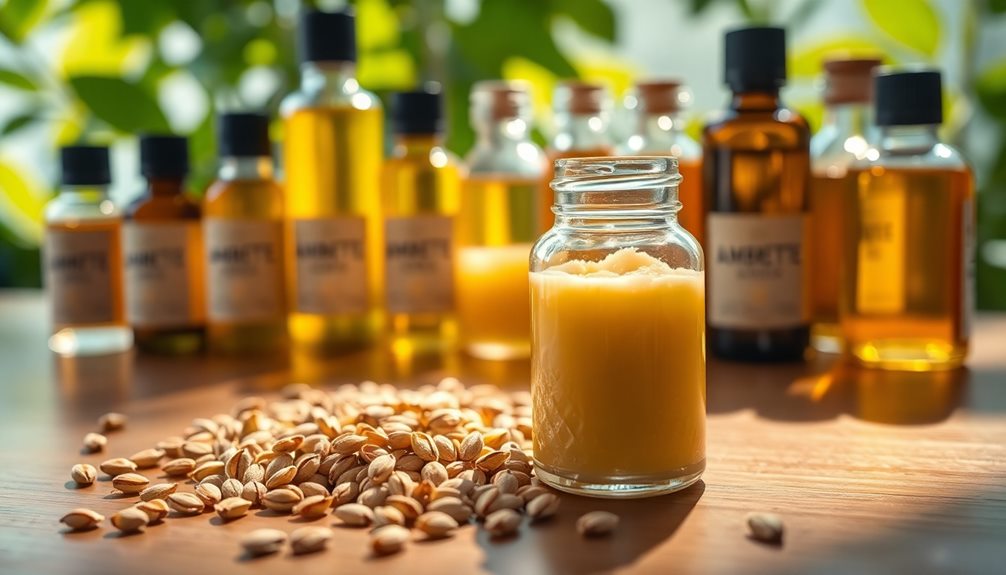To craft ambrette seed absolute, start with high-quality, fully dried seeds. We'll begin with 10-40g, depending on your extraction method. Use a distillation apparatus, including a heat source and condenser, to extract the essence. Add distilled water gradually to prevent dilution. Monitor the temperature closely, heating gradually to volatilize aromatic compounds while preserving oil quality. Ambrette seed absolute, known for its musky, sweet aroma, enhances any perfume with its luxurious notes. This process offers not just a fragrant ingredient, but a sustainable choice in perfumery that creates depth and allure. You'll discover additional nuances to perfect your craft next.
Summary
- Begin with high-quality, fully dried ambrette seeds, ensuring they are stored in a cool, dark place for optimal extraction quality.
- Measure the seeds accurately using a digital scale; 10g is suitable for basic distillation, while larger amounts enhance yield.
- Employ a distillation apparatus that includes a heat source, distillation flask, condenser, and receiving flask for efficient oil extraction.
- Gradually heat the distillation apparatus, closely monitoring temperature to promote volatilization of aromatic compounds and preserve oil quality.
- Utilize distilled water during extraction to prevent impurities, adding it gradually to maintain ideal conditions and ensure uniform consistency.
Aphrodisiac and Calming Properties
Ambrette seed absolute is renowned not just for its distinctive scent but also for its aphrodisiac and calming properties. Historically, ambrette has been used for its relaxing and stimulating effects, making it a valuable component in traditional practices.
You'll find that its rich history includes applications in liqueurs and even coffee, showcasing its versatility beyond perfumery. The enthralling aroma of ambrette can be beautifully complemented by other essential oils, such as Champaca, which is known for its calming and uplifting effects, enhancing its overall impact in unlocking tranquility.
The properties of ambrette are attributed to compounds like ambrettolide, which contribute to its musky and sweet aroma. This scent profile not only enchants the senses but also enhances mood and promotes relaxation.
In perfumery, ambrette serves as a base note, skillfully blending with various fragrance families, including floral and oriental, amplifying their depth and complexity.
When you use ambrette in your formulations, you're tapping into a long-standing tradition of utilizing its calming effects while creating an enticing fragrance. Its applications extend to high-end perfumes, such as *Champs Élysées* by Guerlain, where it acts as a bridge between different scent notes, enhancing the overall olfactory experience.
Fundamentally, ambrette is more than a fragrance; it's a historical and sensory journey.
0 Tons Produced Annually
With the growing interest in natural ingredients in perfumery, the production of ambrette seeds has become increasingly significant. Currently, approximately 60 tons of ambrette seeds are produced annually, primarily in tropical regions like India and Indonesia. This production volume reflects not only the demand for ambrette seed oil but also its value in crafting ambrette absolute, a sought-after ingredient in high-end perfumes.
Additionally, the allure of natural aromatic elements such as agarwood essential oil further emphasizes the trend towards plant-based ingredients in fragrance creation.
Ambrette seed production is labor-intensive, requiring meticulous cultivation practices to guarantee quality and yield. The harvesting process, which occurs from late May to August, is done by hand, leading to lower yields and higher costs. As the global appetite for natural and sustainable fragrance ingredients rises, the methods of ambrette extraction become vital to the overall quality and appeal of the final product.
Various ambrette extraction methods, such as traditional distillation and advanced supercritical CO2 extraction, are employed to produce ambrette absolute. These methods not only influence the scent profile but also determine the marketability of ambrette in perfumery.
Understanding these production dynamics is essential for anyone looking to incorporate ambrette into their fragrance formulations.
Ambrette Seed Extraction Method
To create ambrette seed essential oil, also known as ambrette absolute, you'll need to follow a careful extraction process that emphasizes precision and quality. The essence of ambrette is derived from the seeds of the *Abelmoschus moschatus* plant, which require meticulous harvesting and handling. This process is reminiscent of other essential oil extractions, such as the soothing benefits of Amyris essential oil, which also relies on high-quality raw materials and precise methods.
The extraction is typically done using a distillation apparatus, where the dried seeds release their aromatic compounds when heat is applied. This method yields ambrette butter, which is a pasty form of the essential oil. Further refinement is necessary to achieve the final ambrette absolute.
Before you begin, it's important to gather all your ingredients and equipment to guarantee a smooth extraction process. The quality of the ambrette seeds will greatly influence the scent profile of the final product, so sourcing high-quality, dried seeds is vital. The distillation technique requires precision; hence, a well-calibrated apparatus is essential for ideal results.
Once the oil is extracted, it will possess a musky, sweet aroma intertwined with floral and fruity notes, making it a prized ingredient in perfumery.
Ingredients:
- Dried ambrette seeds
- Distillation apparatus
- Glass containers for collection
Instructions:
Start by confirming your ambrette seeds are thoroughly dried to facilitate efficient oil extraction. Place the seeds into the distillation apparatus, making sure they're evenly distributed for uniform heating. Apply gentle heat to the apparatus, allowing the seeds to release their aromatic compounds.
Once the distillation process is complete, collect the oil, which will appear as a pasty substance known as ambrette butter. This product may require further refinement to remove palmitic acid, resulting in the final ambrette absolute.
Extra Tips:
When working with essential oil extraction, it's essential to monitor the temperature carefully to prevent overheating, which can degrade the quality of the oil. Additionally, make certain that all your equipment is clean and free of any contaminants that could alter the scent profile.
Distillation Apparatus Setup Required
Setting up the distillation apparatus is essential for efficiently extracting essential oils from ambrette seeds. You'll need a few key components for successful ambrette distillation: a heat source, a distillation flask, a condenser, and a receiving flask.
The use of high-quality materials and equipment is important to guarantee the purity of the extracted oil, as demonstrated in aromatherapy and natural remedies.
Start by placing your dried ambrette seeds into the distillation flask, making sure you don't overfill it to allow for steam expansion.
Next, connect the condenser to the distillation flask. This component cools the vapor, allowing it to condense back into liquid form. Verify that the condenser is properly connected to a water source for effective cooling.
After that, attach the receiving flask to collect the ambrette essential oil that will be produced during the distillation process.
Step 1. Prepare Dried Ambrette Seeds

Properly preparing dried ambrette seeds is vital for effective essential oil extraction. This stage lays the groundwork for producing high-quality ambrette essential oil, guaranteeing that you maximize the aromatic compounds derived from the seeds. Here's what you need to focus on:
- Confirm seeds are fully dried to prevent moisture-related spoilage.
- Handle with care to avoid crushing or damaging the seeds.
- Store in a cool, dark place to maintain potency.
- Familiarize yourself with supercritical CO2 extraction for ideal results.
During ambrette seed harvesting, it's essential to select seeds that have reached maturity. Proper drying techniques will enhance the extraction process.
Seeds should be spread out evenly in a well-ventilated area, away from direct sunlight. This prevents degradation of the delicate scent profile.
Once dried, you can weigh the seeds accurately for the extraction process. If you're considering supercritical CO2 extraction, verify your equipment is set up correctly for this method, as it retains the complex aroma compounds more effectively than traditional distillation.
Properly prepared seeds will greatly influence the quality of the final ambrette essential oil, so take the time to do it right.
Step 2. Measure Seed Weight Accurately

Once you've prepared the dried ambrette seeds, accurately measuring their weight is essential for the extraction process. Precise measurements guarantee that you achieve the desired quality and yield of ambrette essential oil. Start by using a digital scale that can measure in grams for the best accuracy.
Here's a simple guide to help you with the measurements:
| Seed Weight (grams) | Recommended Extraction Method |
|---|---|
| 10g | Basic distillation |
| 20g | Supercritical CO2 extraction |
| 30g | Enhanced yield for ambrette butter |
| 40g | ideal for large batch distillation |
When weighing the seeds, guarantee the scale is calibrated and placed on a flat, stable surface. Consider the moisture content in the seeds, as it can affect the weight. Proper ambrette cultivation care prior to harvesting will help maintain seed quality, further influencing the extraction process. By following these steps, you'll guarantee that your ambrette butter is of high quality and suitable for crafting luxurious plant-based musk in perfumery, leading to a more refined final product.
Step 3. Add Distilled Water Carefully

In your essential oil extraction process, adding distilled water is a crucial step that requires careful attention to detail. This addition plays an important role in guaranteeing the efficient extraction of ambrette essential oil, enhancing the overall quality of the final product.
Additionally, incorporating calming oils like clary sage can complement the extraction process, providing the calming benefits that enhance the overall aroma profile.
- Use only distilled water to prevent impurities.
- Measure the water quantity accurately to avoid dilution.
- Add the water gradually to maintain ideal extraction conditions.
- Monitor the mixture to guarantee a uniform consistency.
During the ambrette production process, the right amount of distilled water helps create the perfect environment for extracting ambrette butter from the seeds. This water assists in dissolving essential oils while minimizing unwanted compounds, resulting in a purer final product.
When you add distilled water, remember that too much can hinder the extraction, while too little may not fully extract the valuable oils. By being precise and attentive, you can greatly improve the quality of the ambrette essential oil you produce.
Ultimately, this careful addition is crucial for achieving a luxurious plant-based musk that elevates your perfumery creations.
Step 4. Heat Distillation Apparatus Gradually

As you prepare to extract ambrette essential oil, gradually heating the distillation apparatus is important for optimizing the process. This step guarantees that the temperature increases uniformly, preventing thermal shock to the seeds and maintaining the integrity of the ambrette scent profile.
The careful heating process can also help enhance the overall aroma, much like how unlocking relaxation with balsam fir essential oil can improve mood. Begin with low heat, allowing the apparatus to stabilize before incrementally increasing the temperature.
During distillation, monitor the temperature closely. Aim for a range that facilitates the volatilization of the aromatic compounds without degrading them. Too high a temperature can lead to the loss of delicate notes that contribute to the oil's unique character, a significant aspect of ambrette cultivation.
As the temperature rises, the ambrette seeds will release their essential oils, transforming into a pasty substance known as ambrette butter. This gradual heating not only maximizes yield but also preserves the essential oil's quality, which is fundamental for its application in perfumery.
Step 5. Review Scent Profile Thoroughly

When you explore the scent profile of ambrette seed absolute, you'll encounter a complex olfactory experience that elegantly balances musky sweetness with subtle fruity and floral notes. This plant-based musk is revered for its unique ability to harmonize with a variety of scent notes, making it a staple in modern perfumery. Additionally, incorporating uplifting elements such as revitalizing citrus aromas can enhance the overall fragrance experience.
- Musky sweetness reminiscent of animalistic undertones
- Fruity nuances akin to ripe pears
- Delicate floral hints resembling iris
- Versatility that complements citrus, floral, and oriental fragrances
The primary scent notes from ambrette perfume reveal a multifaceted character. Its signature musky quality is derived from ambrettolide, a prominent compound that distinguishes it from synthetic musk alternatives. The sweet profile enhances its warmth, while the fruity and floral undertones add depth and sophistication.
In your formulations, consider how ambrette seed absolute can serve as a grounding base note or elevate lighter top notes. This complex interplay makes it an essential ingredient in crafting luxurious fragrances, ensuring your final product embodies the richness and allure of nature's finest offerings.
Final Thoughts
The complexity of ambrette seed absolute's scent profile highlights its remarkable versatility and appeal in perfumery. You'll find that ambrette in fragrance offers a unique combination of musky, sweet, and floral notes, creating a luxurious base for various perfume compositions.
Additionally, the calming properties of Australian Sandalwood essential oil can complement ambrette's profile, enhancing the overall sensory experience. The ambrette scent notes, including its fruity hints reminiscent of pears and the subtle floral undertones akin to iris, enhance its desirability among perfumers.
Moreover, the production of ambrette aligns with sustainability principles, as it's derived from a plant source that supports eco-friendly practices. By choosing ambrette, you contribute to the promotion of sustainable agriculture and ethical sourcing in the fragrance industry.
The meticulous cultivation and harvesting of ambrette seeds emphasize the importance of preserving traditional methods while ensuring quality.
As you explore the world of perfumery, consider incorporating ambrette seed absolute into your creations. Its distinct scent profile not only elevates your formulations but also champions sustainability, making it an essential component in modern fragrance development.
To summarize, ambrette's rich olfactory characteristics and sustainable attributes make it a valuable addition to any perfumer's toolkit.
FAQ
Can I Use Fresh Ambrette Seeds for Extraction?
You shouldn't use fresh ambrette seeds for extraction. They need to be thoroughly dried first to guarantee ideal oil yield and quality. Fresh seeds can lead to spoilage and inferior scent profiles during distillation.
How Long Does the Distillation Process Take?
The distillation process typically takes two to four hours, depending on your equipment and the amount of material. Make certain you monitor the temperature closely for ideal extraction and to prevent any degradation of the oil.
What Are Alternative Methods to Extract Ambrette Oil?
You can extract ambrette oil using methods like solvent extraction, cold pressing, or supercritical CO2 extraction. Each technique varies in efficiency and quality, affecting the final product's scent profile and overall characteristics markedly.
Is Ambrette Essential Oil Safe for Skin Application?
Ambrette essential oil can be safe for skin application, but it's vital to dilute it appropriately. Always conduct a patch test first to prevent potential allergic reactions or sensitivities before widespread use on your skin.
Where Can I Purchase Ambrette Seeds for Distillation?
You can purchase ambrette seeds for distillation from specialty herbal suppliers, online marketplaces, or local botanical gardens. Verify they're high-quality and ethically sourced to achieve the best results in your distillation process.
